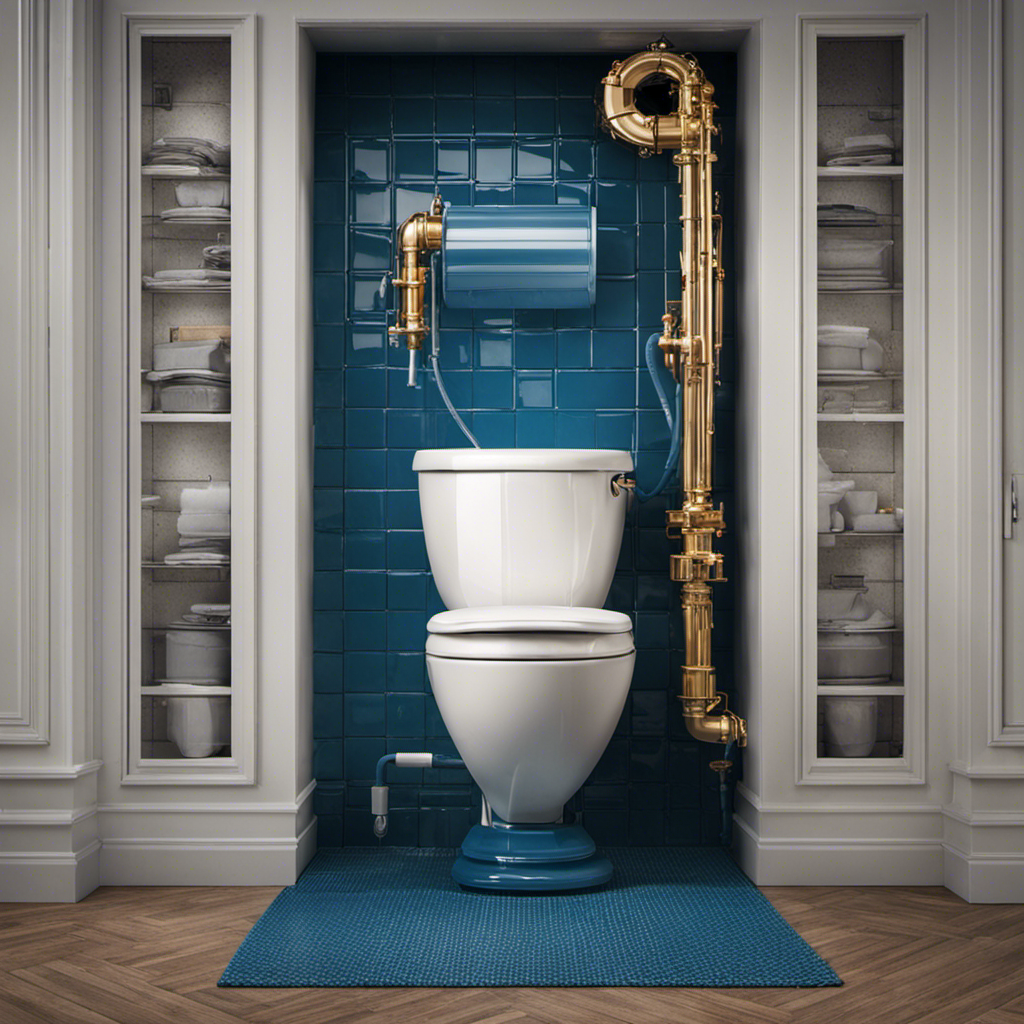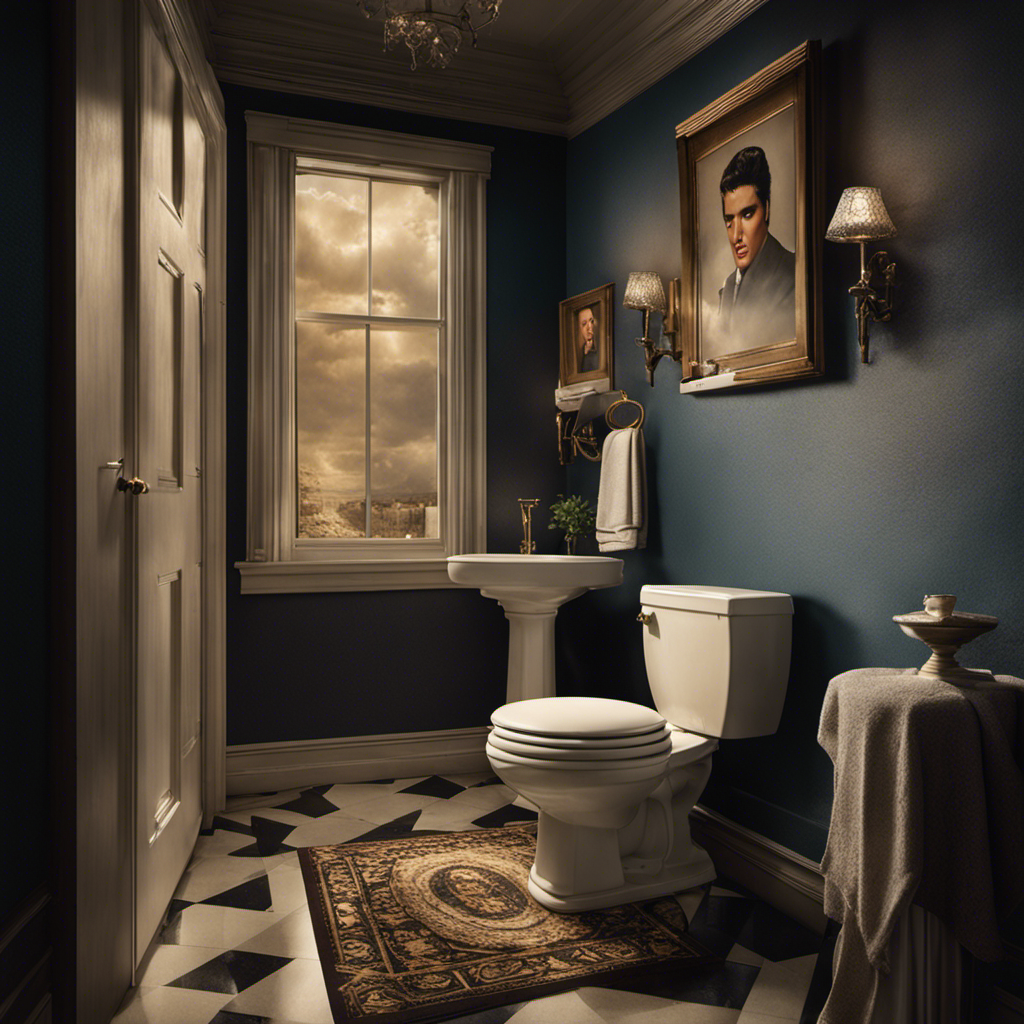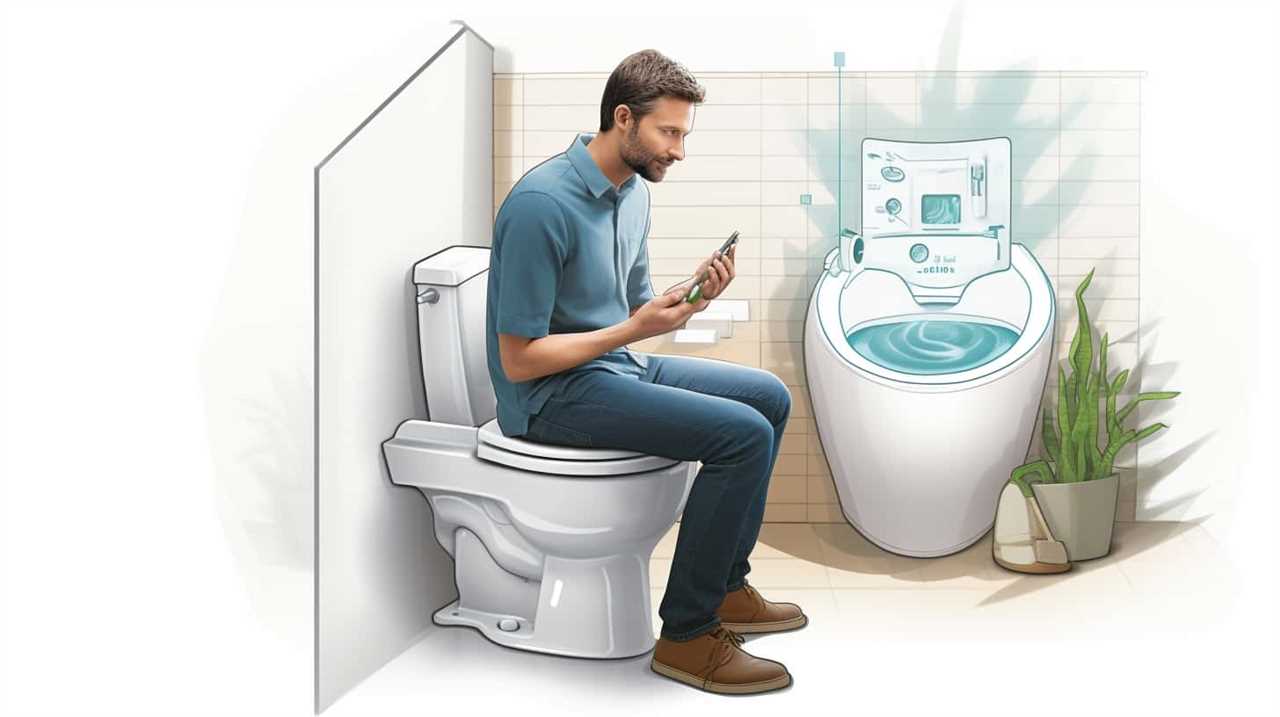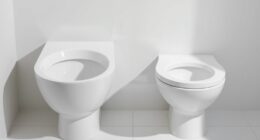Are you tired of the constant sound of running water in your bathroom? Well, fear not! We have the solution for you.
In this article, we will guide you through the steps to get your toilet to stop running. Whether it’s a faulty flapper or an issue with the water level, we’ve got you covered.
So, let’s dive in and put an end to that pesky noise once and for all.
Key Takeaways
- The flapper valve located at the bottom of the tank can cause a running toilet if it is worn out or improperly sealing.
- To check the flapper valve, lift the lid of the tank and observe if water is continuously flowing into the bowl. Inspect the flapper for wear or damage and replace it if necessary.
- Adjusting the water level in the tank is important to prevent excessive flow. The optimal water level should be approximately 1 inch below the overflow tube. This can be done by bending the float arm upwards or downwards.
- Constant flushing can be fixed by checking for leaks, adjusting the chain connected to the flapper valve, and troubleshooting the water level in the tank.
Identifying the Problem
First, you’ll want to check if the flapper valve is causing the issue. The flapper valve is a common culprit for toilet problems, especially when it comes to a running toilet.
The flapper valve is located at the bottom of the tank and is responsible for sealing the water in the tank and preventing it from continuously flowing into the bowl. If the flapper valve is worn out or not sealing properly, it can cause water to constantly leak into the bowl, resulting in a running toilet.
To check if the flapper valve is the problem, simply lift the lid of the tank and observe if the water is continuously flowing into the bowl. If it is, then replacing the flapper valve should solve the issue.
Checking the Flapper
To check the flapper, make sure it’s sealing properly and not causing the toilet to continue running. Here’s how to do it:
-
Lift the lid of the toilet tank and locate the flapper. It’s usually a rubber or plastic piece that covers the flush valve.
-
Inspect the flapper for any signs of wear or damage. Over time, the flapper can become worn out or warped, preventing it from sealing properly.
-
If the flapper is damaged, it will need to be replaced. Turn off the water supply to the toilet, flush it to drain the tank, and then remove the old flapper. Install a new flapper according to the manufacturer’s instructions.
Maintaining and replacing the flapper is crucial for preventing a running toilet.
Once you’ve checked the flapper, you can move on to adjusting the water level in the subsequent section.
Adjusting the Water Level
To ensure your toilet is functioning optimally, it’s important to adjust the water level.
The optimal water level in your toilet tank should be set at a specific height, typically marked on the inside of the tank.
Optimal Water Level
The water level in the toilet should be at an optimal level to prevent it from running. Here’s what you need to know about maintaining the proper water level in your toilet tank:
-
Check the water level: Lift the lid of the toilet tank and observe the water level. It should be approximately 1 inch below the overflow tube.
-
Adjust the float: If the water level is too high, adjust the float by bending the float arm downwards. If it’s too low, bend the float arm upwards.
-
Test and monitor: Flush the toilet and observe if the water level returns to the optimal level. Keep an eye on it over the next few days to ensure it remains stable.
By maintaining the correct water level in your toilet tank, you can prevent unnecessary running and conserve water.
Now, let’s move on to fixing the constant flushing issue.
Fixing Constant Flushing
If your toilet keeps flushing non-stop, you may need to adjust the flapper valve. A constantly running toilet can be a frustrating and wasteful problem, but with a bit of troubleshooting, you can easily fix it.
Start by diagnosing water leaks. Check for any visible leaks around the base of the toilet or the water supply line. If there are no leaks, the issue may lie with the flapper valve.
First, turn off the water supply to the toilet. Lift the lid of the toilet tank and locate the flapper valve, which is usually located at the bottom. Adjust the chain connected to the flapper valve, ensuring that it has enough slack to allow the valve to close completely.
If needed, adjust the water level in the tank to prevent excessive water flow. With these simple steps, you can fix the constant flushing and save water in the process.
Cleaning the Fill Valve
First, check if the fill valve is clean by removing any debris or buildup. This is an important step in toilet maintenance and troubleshooting the fill valve. Here’s what you need to do:
- Shut off the water supply to the toilet by turning the valve clockwise.
- Remove the tank lid and locate the fill valve, which is usually on the left side.
- Gently lift the fill valve cap and inspect for any dirt, sediment, or mineral buildup. Use a soft brush or cloth to clean it.
Cleaning the fill valve can often resolve issues with a running toilet. However, if the problem persists, it may be necessary to replace the flapper. By properly maintaining and troubleshooting your toilet’s fill valve, you can ensure its optimal performance and prevent water wastage.
Now, let’s move on to replacing the flapper to tackle the next potential cause of a running toilet.
Replacing the Flapper
To tackle the next potential cause of a running toilet, you’ll need to replace the flapper. The flapper is a rubber piece that sits at the bottom of the toilet tank and controls the flow of water into the bowl. If it becomes worn or damaged, it can cause water to continuously leak, resulting in a running toilet.
To replace the flapper, start by turning off the water supply to the toilet. Flush the toilet to drain the tank, and then remove the old flapper by disconnecting it from the chain and unscrewing any retaining mechanisms. Install the new flapper by following the manufacturer’s instructions and reattach the chain. Turn on the water supply and test the toilet to ensure the issue has been resolved.
Now that you’ve successfully replaced the flapper and your toilet is still running, it may be time to consider calling a professional.
Calling a Professional
If you’re facing a plumbing issue and you’re not sure whether to call a professional or tackle it yourself, there are a few key points to consider.
First, think about when to call a professional. If the problem is beyond your skill level or requires specialized tools or knowledge, it’s best to leave it to the experts.
Next, consider the cost and availability of professionals in your area. While hiring a professional may come with a price tag, it can save you time, effort, and potentially costly mistakes.
When to Call
When you’re unsure about how to fix your running toilet, it’s time to call a professional plumber. While some toilet issues can be easily resolved with a DIY approach, there are certain signs that indicate a more serious problem that requires professional assistance.
Here are three signs that you should call a plumber:
-
Constant Running: If your toilet continues to run even after you’ve tried basic troubleshooting, such as jiggling the handle or adjusting the flapper, it’s a sign of a more complex issue that needs professional attention.
-
High Water Bills: A sudden increase in your water bills could indicate a hidden leak in your toilet. A professional plumber can identify the source of the leak and fix it to prevent further water waste.
-
Multiple Clogs: If your toilet frequently clogs or experiences slow draining, it could be a sign of a blockage in the pipes. A plumber has the necessary tools and expertise to clear the blockage and restore proper functioning.
Cost and Availability
The cost of hiring a professional plumber for toilet repairs may vary depending on the severity of the issue and their availability. Toilet repair services typically charge an hourly rate, ranging from $75 to $150 per hour, with additional fees for parts and materials. Some plumbers may also offer flat-rate pricing for specific repairs.
Availability can also affect the cost, as emergency or after-hours repairs may come with a higher price tag. Keep in mind that while hiring a professional plumber may be more expensive, it ensures that the repairs are done correctly and efficiently, saving you from potential future problems.
However, if you’re feeling confident in your DIY skills, you can attempt to fix the issue yourself. But be aware that improper repairs can lead to more extensive damage and ultimately cost you more in the long run.
DIY Vs. Professional
When it comes to fixing a running toilet, you have two options: doing it yourself (DIY) or hiring a professional. Both have their advantages, so let’s weigh the pros and cons before making a decision.
Advantages of DIY:
- Cost-effective: By fixing the running toilet yourself, you can save money on hiring a professional.
- Empowerment: DIY projects can be rewarding and give you a sense of accomplishment.
- Flexibility: You can work on the toilet at your own pace and on your schedule.
Advantages of Professional Expertise:
- Experience: A professional plumber has the knowledge and expertise to quickly diagnose and fix any issue with your toilet.
- Quality workmanship: Professionals ensure that the repair is done properly, preventing future problems.
- Time-saving: Hiring a professional means you can focus on other tasks while they efficiently handle the repair.
Ultimately, the decision between DIY and professional expertise depends on your skills, time availability, and budget.
Conclusion
In conclusion, by following these steps, you can put an end to the incessant running of your toilet.
With a little detective work, you can identify the root of the problem and become the hero that saves the day.
Adjusting the water level and cleaning the fill valve are like giving your toilet a soothing massage, ensuring it functions smoothly.
And if all else fails, don’t hesitate to call in a professional, the knight in shining armor who will vanquish any toilet troubles.










